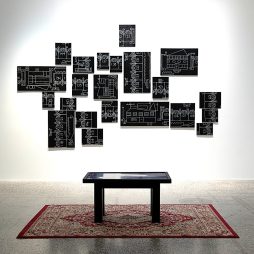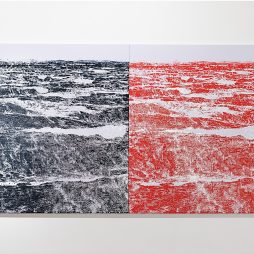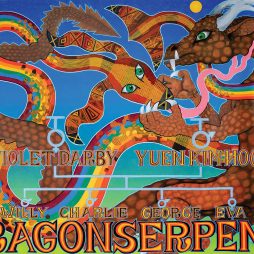REVIEW: Venice Architecture Biennale 2025 + Migrating Modernism: The Architecture of Harry Seidler
With hundreds of contributions that span robotics, AI, and 3-D printed mud structures, a Venice Architecture Biennale in overdrive reveals a confused vision of the built environment’s future. Could a return to modernism’s original scale and site-awareness offer more viable prospects?

Visiting Venice in late June, once the champagne flutes have emptied and the holders of “professional” badges have flown home, offers a different kind of clarity. The pavilions are left to their truest audience—and the blistering heat. As a punishing wave of high temperatures settles over the lagoon, climate change shifts from conceptual backdrop to visceral reality. On the weekend of my visit, electricity was partially down in La Serenissima, yet the city was preparing for one of the world’s richest men and his bride to arrive, along with 200 A-listers in their private jets. Meanwhile, a handful of visitors drifted through the Giardini della Biennale in a slow, sun-dazed procession, and the 2025 Architecture Biennale’s rhetoric took on a searing immediacy.
Curator Carlo Ratti, a professor at Massachusetts Institute of Technology and head of the Senseable City Lab, grapples with how to think collectively about intelligence in his curatorial proposal. Titled Intelligens. Natural. Artificial. Collective, the Biennale foregrounds hybrid knowledge systems—from scientific to indigenous, digital to artisanal—as essential tools for rethinking the built environment in an age of climate crisis. Rejecting the traditional model of curation, Ratti issued an open call for submissions and selected more than 300 multidisciplinary teams, spanning mathematicians, artists, engineers, fashion designers and woodcarvers. “Imagination alone isn’t enough,” he says. “Artists and architects need science.”
The opening salvo is strong. Visitors enter the Arsenale’s cavernous, darkened hall, where reflective pools glint underfoot, giving the eerie impression that one misstep could plunge you into the abyss. Titled The Third Paradise Perspective, the work by Michelangelo Pistoletto’s Foundation, Cittadellarte, adopts the artist’s signature symbol of interlinked circles representing harmony between humanity and nature. Here, it doubles as a haunting meditation on Venice’s projected sea-level rise by 2100. Overhead, suspended air conditioners thrum with noise and exhale hot air. Meant to illustrate being on the “wrong” side of an AC unit, they are, in fact, fakes: the heat comes from hidden compressors. Created by the German firm Transsolar KlimaEngineering, it’s nevertheless a sharp commentary on the paradox of climate control contributing to climate collapse.
With 2024 already the hottest year on record, Ratti’s message is clear: architecture must break from business as usual—or risk accelerating its own obsolescence. But the clarity of the curatorial vision soon melts away in the presentations that follow. It’s a show that overwhelms rather than guides, leaving visitors to fend for themselves in a labyrinth of drones, sensors, AI constructs and post-human habitats. What begins as an invitation to rethink architectural intelligence dissolves into a chaotic sprawl of competing visions, speculative gestures, and climate-conscious set pieces that range from inspired to incoherent.
With the Central Pavilion at the Giardini closed for renovation, the main exhibition is relegated entirely to the Arsenale, where it feels dense to the point of disorientation. Contributions veer between the poetic and the esoteric. One installation features Bhutanese craftsmen carving mythic dragons into timber alongside robots replicating their work—a tableau of coexistence, if not always collaboration. Robots zoom across the Arsenale; one hangs upside down in a steel cage. Yet amid the tech, a different material language emerges through the use of earth tones, fungal bricks, elephant dung. The future, Ratti seems to suggest, may be biodegradable—or not built at all. But for the most part, 3D-printed loam structures appeared to be the best this collective of minds could conjure.
And then there’s the Golden Lion-winning Canal Café by Diller Scofidio + Renfro—a performance piece masquerading as environmental prototype. Lagoon water is drawn and filtered on-site through a transparent bio-filtration system, and turned into espresso served in a minimalist café setting. Conceptually, it’s clever: an eco-ritual that reclaims polluted water and repositions it as social currency. But behind the alchemy is little infrastructure. There’s no roadmap for scalability, no engagement with Venice’s wider water crisis—just a gesture made drinkable.
Meanwhile, at the national pavilions across the Arsenale, Giardini, and in off-site locations, heat becomes a symbol rather than a sensation. The Golden Lion-winning contribution of Bahrain, titled Heatwave, is a study in passive cooling. It reimagines traditional Middle Eastern typologies with suspended seating and shade structures. But technical limitations forced the use of mechanical ventilation—an irony not lost on critics. The pavilion becomes a metaphor for adaptation under duress: inventive, evocative, but ultimately compromised. In contrast, Germany’s STRESSTEST builds on a similar premise with architectural precision. Split into two zones—Stress and De-Stress—the pavilion resembles a climate split-screen. On one side: a heat-retaining metal chamber warmed by solar mats, where visitors’ body temperatures are projected using infrared cameras. Graphs show rising temperatures and casualty numbers linked to heatwaves. In the centre, a somewhat didactic but accessible film outlines the impact of “developers’ architecture” on urban heat: glass and steel facades bouncing heat back onto shade-less sidewalks. On the other side: a shaded microclimate filled with hornbeam trees, cooled by natural ventilation and evaporative systems. Change, the pavilion argues, is within reach—and doesn’t require AI. It’s both experiential and infrastructural, a rare harmony of narrative and engineering.
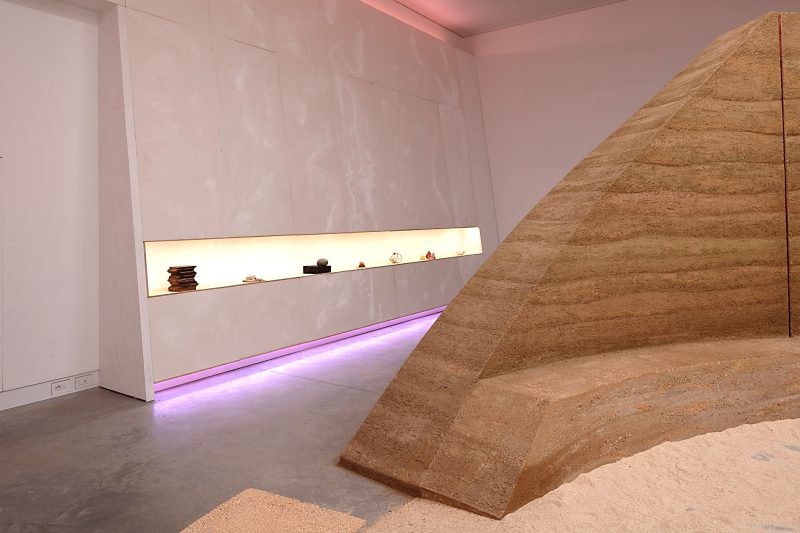
Installation view, ‘Home’, 2025, Pavilion of Australia, 19th International Architecture Exhibition, Intelligens. Natural. Artificial. Collective. Curated by Carlo Ratti for the La Biennale di Venezia. Photographed by Peter Bennetts
Other national contributions take a more poetic route. Australia’s Home pavilion—the country’s first led entirely by First Nations architects and designers—offers a profound counterpoint to the Biennale’s techno-futurist leanings. Barefoot visitors enter a circular space composed of rammed earth, ochre and gypsum plaster. Around the perimeter, over 120 “living belongings” rest on a recessed shelf. Handcrafted by architecture students, these objects invite touch, contemplation and care. I was especially drawn to a black earthenware decanter, one of the more utilitarian items visitors could handle. More than installation, Home is participatory ceremony. Through indigenous storytelling methods like the yarning circle, it reframes the pavilion not as showcase but as shared space. In a Biennale brimming with conceptual noise, its stillness feels radical.
In many ways, this year’s Biennale reads as a rebuke to the legacy of modernist architecture—its steel, concrete, and carbon-chugging heat, ventilation and air conditioning systems now symbols of environmental recklessness. But it wasn’t always so, at least not in the hands of the modernist masters. The newly minted San Marco Art Centre Venice, located near St. Mark’s Square, has launched a timely exhibition dedicated to one of modernism’s most compelling yet underappreciated figures: Harry Seidler. Best known as a pioneering Australian architect who fused European modernism with Australian contexts, Seidler’s work is now receiving overdue attention in a setting that resonates with his cosmopolitan yet regionally rooted ethos.

Migrating Modernism. The architecture of Harry Seidler (installation view), with photographs by Max Dupain and David Moore. SMAC San Marco Art Centre, Venice, 2025. Photographed by Enrico Fiorese (Australia Square Precinct)
A joint project with the Chau Chak Wing Museum, University of Sydney, Migrating Modernism: The Architecture of Harry Seidler, opens with Seidler’s childhood in Vienna, marked by upheaval and resilience. Born into a Jewish family in 1923, Seidler was sent to England as the Nazis annexed Austria. He was later interned in England and Canada as an “enemy alien”—a period of forced displacement that profoundly shaped his worldview. It was also where he began studying art and architecture through self-organised courses in the camps. After the war, Seidler studied under Bauhaus titans Walter Gropius and Marcel Breuer at Harvard, absorbing lessons in functionalism and humanist modernism. He worked briefly in Breuer’s New York office and with Josef Albers at Black Mountain College before being summoned by his parents—who had emigrated to Sydney—to design their home. That house, the Rose Seidler House, completed in 1950 in Wahroonga, was a bold modernist statement in a conservative climate. Its impact launched his Australian career, and Seidler never returned to the United States.
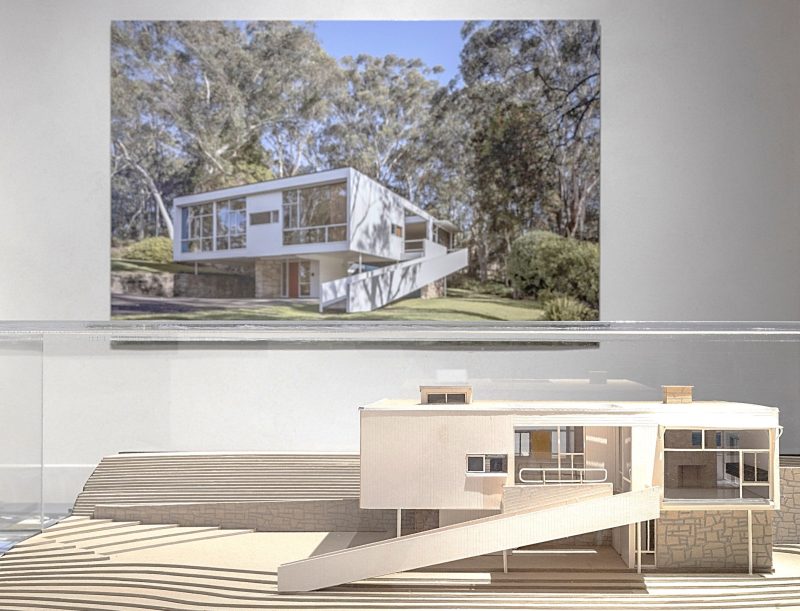
Migrating Modernism. The architecture of Harry Seidler (installation view), with photographs by Max Dupain and David Moore. SMAC San Marco Art Centre, Venice, 2025. Photographed by Enrico Fiorese (Seidler House)
Large-format photographs of landmark projects like the Australia Square precinct are paired with early sketches and models, tracing Seidler’s geometric clarity and pioneering use of concrete. The sculptural rigor of his buildings gain new weight when viewed alongside his biography of survival and reinvention. Of note is the section on Seidler’s public architecture, where his ability to marry monumentality with human experience shines. His vision for urban density, as seen in Australia Square’s cylindrical tower, anticipates today’s debates on city living. Archival footage and interviews with his wife and collaborator, Penelope Seidler (née Evatt), enrich the exhibition’s emotional dimension, revealing a modernist deeply attuned to how people inhabit space.
EXHIBITIONS
19th Venice Architecture Biennale
10 May – 23 November 2025
Migrating Modernism: The Architecture of Harry Seidler
9 May – 13 July 2025
San Marco Art Centre, Venice
Migrating Modernism: The Architecture of Harry Seidler
July 2026 – January 2027
Ian Potter Gallery, Chau Chak Wing Museum, University of Sydney, Sydney
Images courtesy of La Biennale di Venezia, Venice, Australian Institute of Architects, Melbourne, Penelope Seidler AM, SMAC San Marco Art Centre, Venice, Chau Chak Wing Museum at The University of Sydney, HOME Creative Directors & Creative Sphere (Creative Directors: Jack Gillmer- Lilley, Emily McDaniel and Dr. Michael Mossman and Creative Sphere: Clarence Slockee, Kaylie Salvatori, Elle Davidson and Bradley Kerr)
Hili Perlson is a writer and lecturer based in Berlin.
This article was first published in Artist Profile Issue 72

